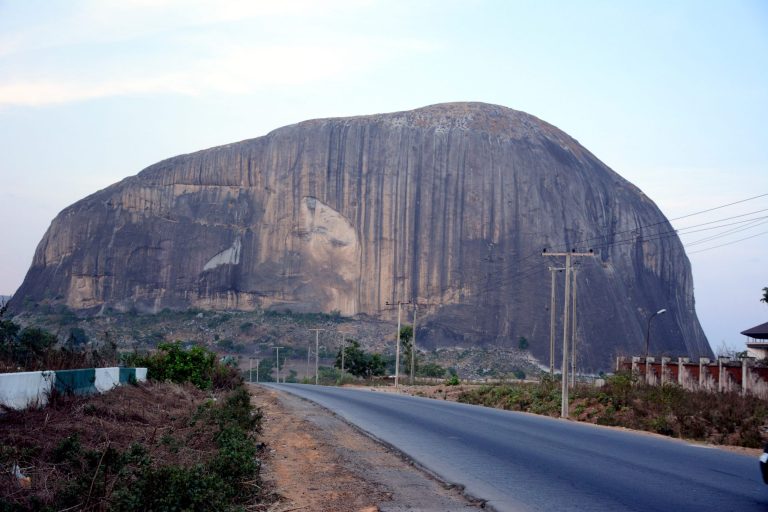… Nigeria Has No Shortage Of Beautiful Scenic Spots
Nigeria is a total tourism package endowed with the awes of nature with no shortage of beautiful scenic spots to experience, love and enjoy.
. The Federal Capital Territory (FCT), Abuja – The Nigeria ‘Centre of Unity’ rocks the world with its Zuma Rock.
The Zuma Rock which is popularly referred to as the gateway to Abuja from Suleja, is situated five miles to the south-east of the Suleja along the main road from Abuja to Kaduna off Madala.
The spectacular rock that rises 725 metres (2,379 ft) above its surroundings has natural contours on the surface depicting the image of a human face with a visible mouth, eyes, and nose. The natives of the community believe the face represents the deity and ancestral powers protecting, healing and overseeing the affairs of the people of the community. These indigenous myths and beliefs contribute to a unique cultural and spiritual dimension that attracts visitors from within and outside the country to the rock, beyond its geological features.
. Katsina State – The ‘Home of Hospitality’ is endowed with Kusugu Well, an historical landmark in Daura. The legendary well is said to have been discovered in the 7th century and became the source of water for the people at the time. However, history has it that a formidable snake called Sarki which means ‘Chief’, only allowed the people of Duara to fetch water on Fridays. The snake was killed with a sword in the 10th century by Bayajida. Today both local and international tourists who visit Daura never miss a chance to see the monument.
. Plateau State – The ‘Home of Peace and Tourism’ is one of the most endowed States in Nigeria with natural formations of rocks, hills, wildlife parks, waterfalls and cool weather ambience. However, one of the most spectacular of the lot is the Assop Waterfalls, a natural waterfall located about 70 kilometers along Jos-Kagoro road. The waterfall gushes from the bottom of Hawan kibo, a rocky hills that floods down the valley.
. Sokoto State – ‘Seat of the Caliphate’ attracts visitors from far and near with its Goronyo Dam. The dam impounds the Rima River in Goronyo Local Government Area of Sokoto State thus revealing a beautiful view from the top that showcases the contrast between the beautiful blue Rima River on one side, and the land on the other. The dam is described as the perfection of the collaboration between human creativity and nature. The Goronyo Dam was completed in 1984 and commissioned in 1992. The dam is a sand-fill structure with a height of 21meters and a total length of 12.5 kilometers. It has a storage capacity of 976 million cubic meters.
. Yobe State – ‘Pride of the Saheal’ flaunts its Dofarga Spring Water known as the most abundant spring water source in Nigeria. The spring water gushes both hot and cold water from the ground and flows down into streams. The spring however maintains a constant temperature at the point where the hot and cold water meets. Dofarga spring water is located in the South of Buni – Yadi, Gujba Local Government and runs through Dokshi town of Gulani Local Government Area Yobe. What are you waiting for? Take that trip to Yobe State and experience the one of a kind beautiful spot in the country.
. Zamfara State – With its slogan of ‘Farming is our Pride’ also takes pride in its magnificent Kwatarkwashi Rock which is one of the most exotic natural rock formations in Nigeria with about 350 meters above sea level and about 1 square mile. The Rock is located in Kwatarkwashi Town of Bungudu Local Government Area, 12 km from Gusau, the capital city of Zamfara, Nigeria.
The Kwatarkwashi rock also serves as home to a natural spring that never runs dry, providing cool, refreshing water. This crystal clear spring gushes out as it adds beauty to the Kwartarkwashi rock.
Indeed, Kwatarkwashi rock is the true definition of the beauty of nature, one that should be beheld by lovers of nature. The surrounding scenery offers natural ambience for relaxation and adventures.
However, history has it that the rock is an abode for some powerful spirits, and settlers in the past used the rock for worship, and the performance of the ceremony called ‘Daukar Maiki’ (catching of the eagles). This is because Eagles used to live in the caves and catching them was the main feature of Daukar Maiki. Also, locals used to hide in some of the caves within the rock during battles as the biggest of the caves can hide about a thousand people at once.
